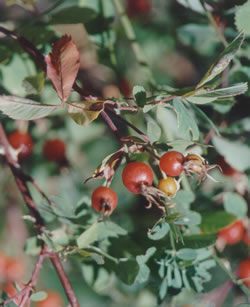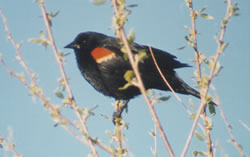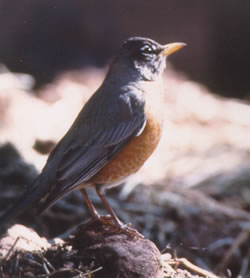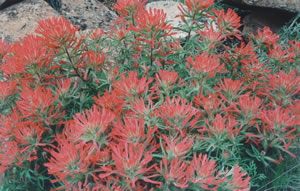|
 If
I were to assign colors to the months, I would select red
for March. Green would be a close second, but I’d save
that one for June or July. If
I were to assign colors to the months, I would select red
for March. Green would be a close second, but I’d save
that one for June or July.
So why red? Perhaps it has to do with the house finches that
have started their sweet singing in my backyard. From high
atop the neighbor’s tree or perched on an old bird feeder,
the males sport brilliant red head and body feathers as they
belt out their songs. Though they disappeared from my feeders
around Christmas, they are back in numbers. Nicknamed “Hollywood
finches”, after their original western distributional
range, these birds steal the show.
Other current backyard birds that sport some red are the cedar
waxwings and ruby-crowned kinglets. The waxwings appear each
day in tight flocks held together by constant chattering.
Their high-pitched whistles announce their arrival and presence
as they work over the hackberry fruit. Spots of red on their
wings contrasts sharply to the yellowish tips of the tail
feathers.
The kinglets mix in with the house and gold finches; occasionally
a male will display its red feathery cap that stays hidden
beneath duller colored feathers. The males use these feathers
in mating displays, and it seems, from the antics in the backyard,
to make some type of statement to the persistent finches.
 Farther afield, it is the northern flickers, red-winged blackbirds
and spotted towhees that catch my eye. The red-shafts of the
flicker’s tail feathers once contributed to the common
name of this woodpecker (Red-shafted flicker), but ornithologists
changed the name to better suit the bird’s distribution.
The red cheek stripe indicates a male; the females lack this
moustachial stripe. Their current behavior includes territorial
displays, chases, courtship, and drumming on dead snags or
the metal light covers by the City ballfields.
Farther afield, it is the northern flickers, red-winged blackbirds
and spotted towhees that catch my eye. The red-shafts of the
flicker’s tail feathers once contributed to the common
name of this woodpecker (Red-shafted flicker), but ornithologists
changed the name to better suit the bird’s distribution.
The red cheek stripe indicates a male; the females lack this
moustachial stripe. Their current behavior includes territorial
displays, chases, courtship, and drumming on dead snags or
the metal light covers by the City ballfields.
The towhees and blackbirds I see at the Matheson Preserve,
or hear might be a better definition. Songsters of spring,
the male blackbirds select exposed perches and sing their
konk-la-reee songs, then chase away rival males. The cacophony
of singing males is a true harbinger of spring. Where the
blackbirds sport epaulets of red, the towhee, both males and
females, have flanks of orange-red and eyes the color of glowing
coals.
But it isn’t just the birds that bring bright splashes
of crimson to the awakening landscape. Water birch and Utah
serviceberry are two woody plants whose bark coloration is
red. Found along the streambanks in Negro Bill Canyon, there
are water birches growing along the trail with bark smoothed
to a satin finish due to the stem-clasping hands of hikers.
The serviceberry shrubs may be found in the riparian areas
or in drier upland sites. These Rose Family members may still
bear some of their reddish fruits from the past season.
 Even
more of an interrupting sight is the splattering of Indian
paintbrush that seem to erupt from the desert soil. These
plants perform a slight-of-hand trick - their flowers are
not technically red. The plants have red bracts that enclose
greenish flowers as a way to lure pollinators. The plants
are also partially parasitic – their roots rob other
plants of nutrients and water – an advantage for the
paintbrush that does not seem to impact the host. Even
more of an interrupting sight is the splattering of Indian
paintbrush that seem to erupt from the desert soil. These
plants perform a slight-of-hand trick - their flowers are
not technically red. The plants have red bracts that enclose
greenish flowers as a way to lure pollinators. The plants
are also partially parasitic – their roots rob other
plants of nutrients and water – an advantage for the
paintbrush that does not seem to impact the host.
So whether it is in the feather of a bird or the stem of a
shrub or the makeup of a flower, I vote for red as the color
of March. Bright and brilliant this color shouts “spring!”
and after this long winter, that is a welcomed word. And,
of course, how could I forget to mention Robin Redbreast (AKA
American robin), the (almost) official songster of spring
whose whinny and cheery call wake me up each morning.

|